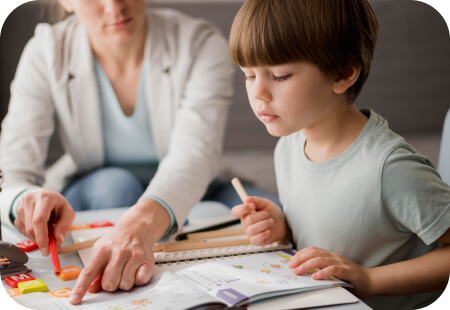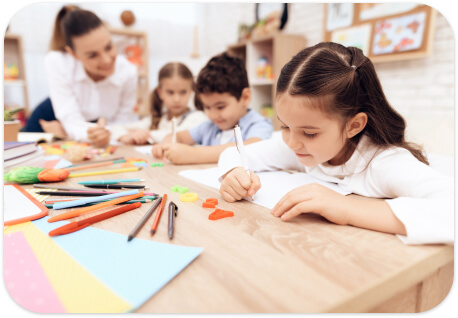During the past few decades, technology has been an incredible catalyst in transforming nearly every aspect of our lives. In today’s world, most people would struggle to function normally without regular access to their electronic devices.
These tools allow us to work from home, talk with relatives who live far away, and accomplish many more tasks that we take for granted.
One domain that’s still very early in it’s adoption of technological innovation is the education sector. The world wide web has given everyone access to take college courses online and learn new skills from experts all from the comfort of their couch. When it comes to younger students in elementary school and middle school we still haven’t seen much evolution. This is true of private schools, but especially for public schools where funding can be an issue.

As we explore technology applied to school, it’s natural to wonder what effects it can have on our youth and how extensively it should be used in schools to improve education outcomes. In the following text, we’ll discuss some of the areas that could be positively affected by implementing technology and others where it may be best to find alternate teaching solutions.
Technology is a catalyst for innovation
To understand how impactful technology can be in the present, it’s key to go through the simple exercise of looking at the past. Changes that would originally seem far fetched can swiftly zoom into reach when the lens and scope of history are applied.

Electronics have brought on an even more rapid rate of innovation, making anything possible.
As we study this topic, we’ll need to lay aside our understanding of how teaching works today. Instead, let’s ask ourselves with an open mind how the learning process could change if we applied best practices from across the world. Only this way can we strive to obtain the best learning outcomes for all students.
Remote Learning and Virtual School Classrooms
Close your eyes for a quick minute and picture the classroom of the future.
Of all the radical changes that we can imagine, remote learning in virtual classrooms is one of the most immediately easy to picture. In fact, many businesses have needed to adapt to this as a day to day reality during the COVID pandemic. The importance of distance education has grown rapidly due to this situation.
Let’s quickly review the definition of remote learning: it’s when the student and the educator are not physically present in a traditional classroom environment. Instead, they work together via technologies such as video conference software.
It’s not too far of a stretch to accept that there’s a place for remote learning technologies to supplement or improve traditional teaching even after it’s no longer a necessity.
While imagining students submerged in virtual reality goggles connecting online all day may not be a welcome thought for some, there’s no need to fret. The true evolution of teaching and learning will likely be much more incremental and happen slowly.

The next evolution could be as simple as moving towards distance learning where students no longer need to be present in physical classrooms for part of the day. They would simply follow the same lesson plan from their home.
We can also imagine scenarios where students from around the world share a common virtual classroom and all benefit from a common optimized platform. In this scenario the teacher is the one who could be remote or asynchronous and the students could still be within a school.
Virtual classrooms would also bring into question whether or not the school year with a large break in the summertime needs to exist. Children could avoid the summer “brain drain” by having a more consistent learning schedule.
One thing for sure is that sitting behind a desk in a classroom the entire school year seems a less and less likely outcome for the majority of students going forward.
The Evolution of Teaching in Schools
The next obvious target for innovation would be improving the way that teaching and learning activities are conducted.
If we have a hard honest look at the current state of the classroom, it becomes clear that many of our seemingly modern teaching institutions are stuck in a rut. There’s nothing like a pile of papers coming home everyday in a backpack to remind you that traditional learning hasn’t changed much in the past few decades.
If we want to make a step change in maximizing each student’s growth then we have to be willing to consider making fundamental changes to the underlying teaching processes and change teaching itself.
This means re-visiting the idea of teachers lecturing in class to a large classroom. Instead, it’s increasingly likely that we’ll someday have Artificial Intelligence bots take over some of the basic functions in the classroom. This will help to free up teachers for higher yielding activities that are much more personalized to each student.
In particular at the K-12 level of education, the knowledge that’s being taught is well established and evolves slowly if at all. This means that we should be able to capture the best in teaching methods and knowledge and build highly competent Artificial Intelligent entities via machine learning.
With public school districts currently heavily burdened by budget deficits, relief in the form of inexpensive but reliable technology will be a welcome bonus. This may actually be one of the only feasible solutions to providing a high quality education for everyone.
In addition to the potential for improving the quality of teaching by more extensively leveraging technology in the classroom.
Another huge windfall from technology will be leveling the playing field for every student by creating a custom tailored adaptive learning experience for them. This will give each and every student the same best in class learning opportunity.
Electronic School Textbooks
Advancements in technology could replace things such as tests, textbooks, and lectures.
Technology can help replace the need for paper testing because students could take the test online. However, technology could change how testing is done because if everything went virtually, it could be hard for teachers to enforce a closed book exam—not being able to implement these closed-book exams could change how textbooks and lectures are made.

Textbooks could become all-digital, so instead of getting a physical paper textbook, students could be given access to a secure website link. However, textbooks could also be a series of videos explaining the topics in the textbook.
Lectures could also change and give more options for teachers. The teachers could pre-record lectures and give them to students to watch on their own time. However, this approach forces teachers to lose a connection to students because they will not be interacting with them.
The other approach would be to have live classes where the teacher talks to students. This approach would be closer to the traditional sit-down lectures that most students participate in now and allow for some interactive sessions with students.
School Grades and Record Keeping
Future technology could also change how records are kept for students and how reports are sent to parents and students to inform them of their grades.

Report cards and records could be kept entirely digitally, where all parties involved have easy access to them.
Having technology replace report cards could potentially allow students to get an up to date understanding of how they are doing and potentially lead to them getting help sooner rather than later.
Technology also has the potential to help improve communication between the parents and teachers because parents could be kept more up to date on how their child is doing.
Classroom Elements that Technology Cannot Replace
Technology can make so many changes to schools. However, there are potential downfalls and areas where technology could not make any changes.

Technology cannot directly impact how children think when they are in the classroom.
Technology might be able to replace many aspects, but children would still be missing out on some critical areas if classes were online. Technology cannot replace the social interactions that are important to children when they are in elementary or middle school.
Children of this age make great friends, and technology could not replace that. Putting classrooms online could potentially hurt the social learning that comes from direct interaction.

Technology also can not replace the interactions that take place from teacher to student. Many people have experiences where one teacher can have a significant impact on their lives. Technology will not be able to replace those mentorship connections.
Learning in the classroom will also always need to remain the same. Technology can only be used as a delivery mechanism for the material but can not make any changes to the fundamental nature of the learning that takes place.
The content will evolve to match the medium that it’s delivered in but the underlying science of how we learn will ultimately be driven by our own human nature and constitution. Ultimately, technology can not change many aspects of how we best learn math, science, or English.
No matter how advanced classroom technology becomes, students will always need to put in the work to learn a subject. Technology might be able to change the format of the work that has to be done, but technology will not be able to change the fact that students still have to complete work. Doing work is a critical element of learning, and technology can not change that.
There are some areas of classrooms that technology is not able to improve upon. For example, technology can not make a student ask better questions. Students are still going to ask the same questions.
Technology can also not make students learn better. Many students learn material differently, and technology will not be able to harness a universal way of making students learn the material.
Technology also can not improve the quality of thinking and critical thinking that a student is doing. If not leveraged correctly, technology might make it harder for students to think critically.
Closing thoughts
Technology has clear benefits and will continue to shape our lives in ways that we could never imagine.
Technology has and will continue to make changes to the classroom setting.
Classrooms today likely look very different from the classrooms that we studied in when we were young students, and classrooms tomorrow will continue to evolve at an even more rapid pace.

While remote learning in education can change the classroom, it is important to understand that technology can not change every aspect of the classroom. We have to apply it carefully.
While considering the application of new technology enabled techniques, we cannot forget the learning that takes place from social interactions between kids, with teachers, and the vital role that environment plays in growing up.
GrowMindGrow is a remote learning company focused on elementary school education (grades pre-k to 5th grade).







